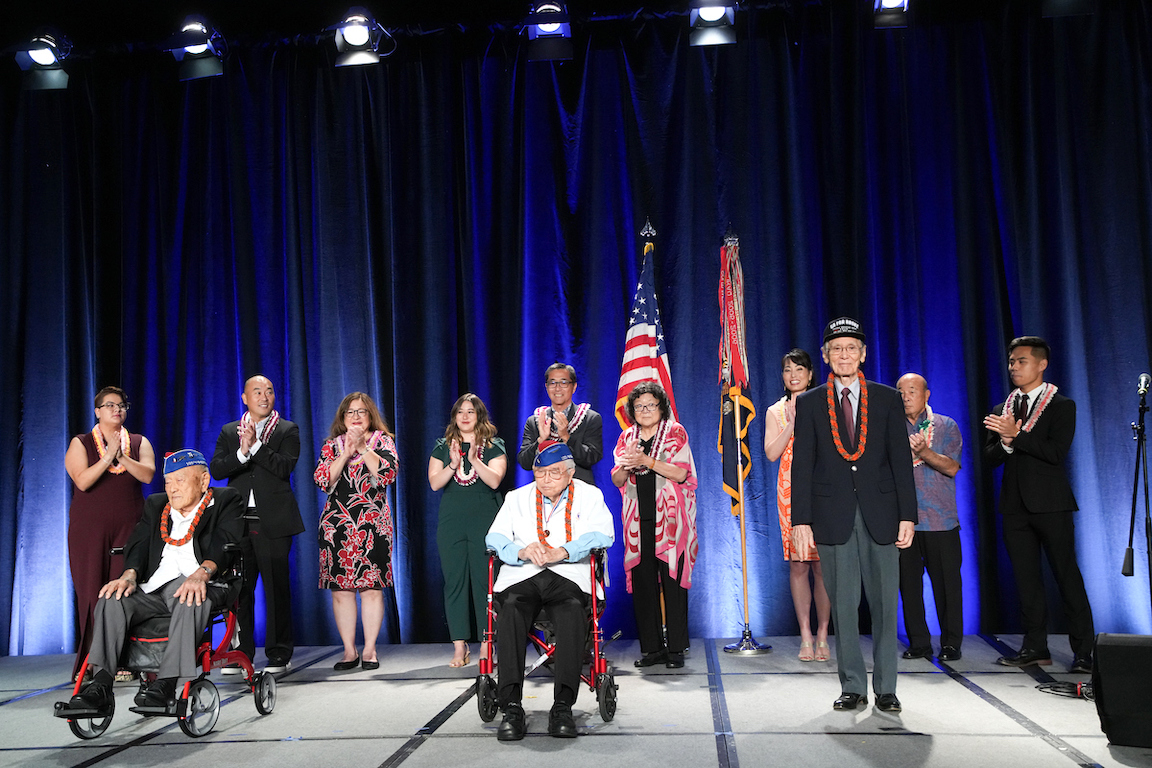
In the foreground (from left) are Tokuji Yoshihashi (100th Battalion), Yoshio Nakamura (442nd) and Ed Nakamura (MIS). The trio of Nisei WWIl veterans were in attendance at Sept. 23’s Annual Evening of Aloha fundraising dinner and celebration at the Westin Bonaventure in downtown Los Angeles. (Photo: Tracy Kumono)
The 22nd Evening of Aloha Honors Vets, Bets on Expansion Plan.
By P.C. Staff
On the surface, Sept. 23’s annual fundraising gala for the Go for Broke National Education Center at a tony downtown Los Angeles hotel ballroom was as celebratory, festive and heartfelt as any of the 21 Evenings of Aloha that preceded it.
The food was as tasty as ever, thanks to Roy’s Restaurant chain founder Roy Yamaguchi, who created the menu, and chef Andreas Nieto, who led the Westin Bonaventure Hotel & Suites culinary team.
The master of ceremony duties by Chris Komai — filling in for KABC-TV Channel 7 news anchor David Ono — were handled with aplomb.
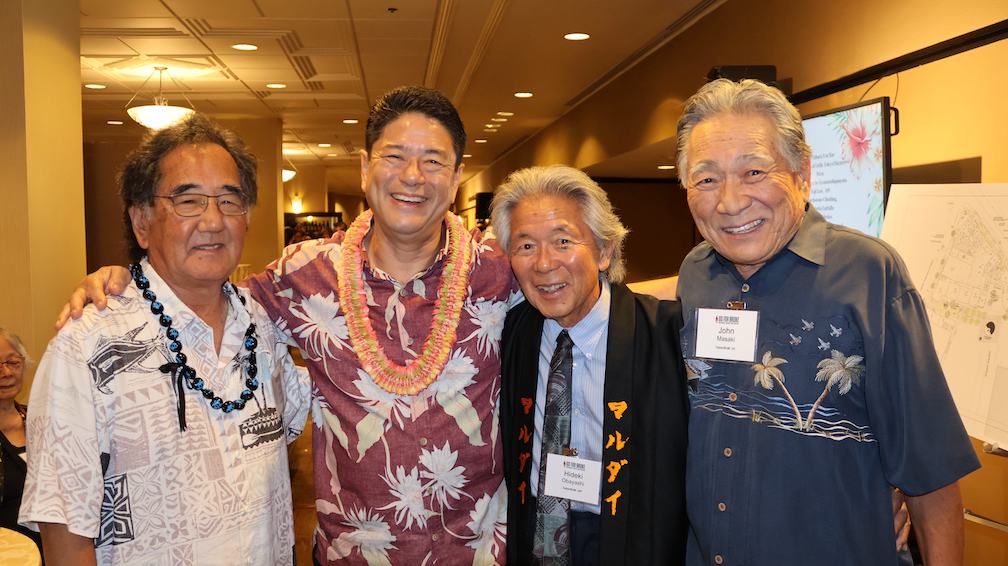
Pictured (from left) are Don Bannai, GFBNEC’s Mitch Maki, Hideki Obayashi and John Masaki in attendance at the 22nd Annual Evening of Aloha celebration. (Photo: George Toshio Johnston)
The presentation and retiring of flags by the 100th Battalion/442nd Infantry Regiment color guard were handled with precision, the music was cheery, the videos were inspiring and the words from such speakers as GFBNEC Board of Directors Chair George Henning, Rep. Mark Takano (D–Calif.), comedienne and GFBNEC volunteer Sierra Kato, former Alhambra Mayor Jeff Koji Maloney, Dr. Maya Hernandez and, of course, GFBNEC CEO and President Mitchell T. Maki were all first-rate.
But as one attendee noted, it seemed there were fewer in the audience than in previous years.
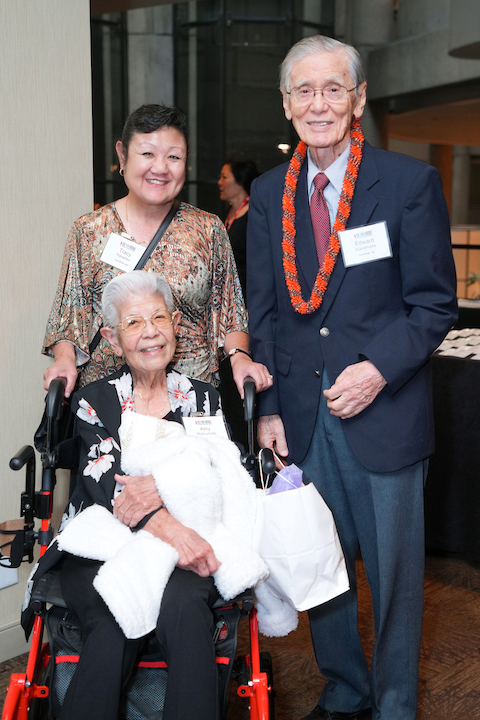
Nisei veteran Ed Nakamura (MIS) with Amy Matsumoto, wife of Ralph Matsumoto (MIS) and her daughter, Tracy Haselau. (Photo: Courtesy of GFBNEC)
This time there were only three veterans — Ed Nakamura (Military Intelligence Service), Yosh Nakamura (442nd) and Toke Yoshihashi (100th/442nd), all centenarian-adjacent — who took the stage to accept the audience’s applause and adulation.
The lower turnout wasn’t imaginary. In an interview with Pacific Citizen conducted a few days after the event, Maki noted that there were 450 people in attendance. “Five years ago, we had 1,000. When veterans pass, their families don’t always stick around. So, there are challenges for us as we push forward and as we begin to redefine and recreate ourselves to make ourselves relevant for the next generation.”
In a way, it’s completely understandable when you are an organization whose raison d’etre is to celebrate and memorialize American soldiers from a small ethnic group who served with particular distinction in a war that ended nearly eight decades ago.
That the day would arrive when there were no more 442 or MIS veterans to fete was something everyone knew was inevitable. That time, sadly, is nearly here.
“We are in a transition at Go for Broke National Education Center just because the veterans are leaving us so quickly,” said Maki.
Although an undeniable truth, GFBNEC is nevertheless taking action to belie the bromide “old soldiers never die, they just fade away.”
Inspired by the gambling expression from which it derives its name, Go for Broke is staking its future to not fade away on a construction project called First Street North, which will run along Temple Street between Judge John Aiso Street to the west and Alameda Street to the east, with an elbow of construction running south along Aiso Street. It will break ground in early 2024.
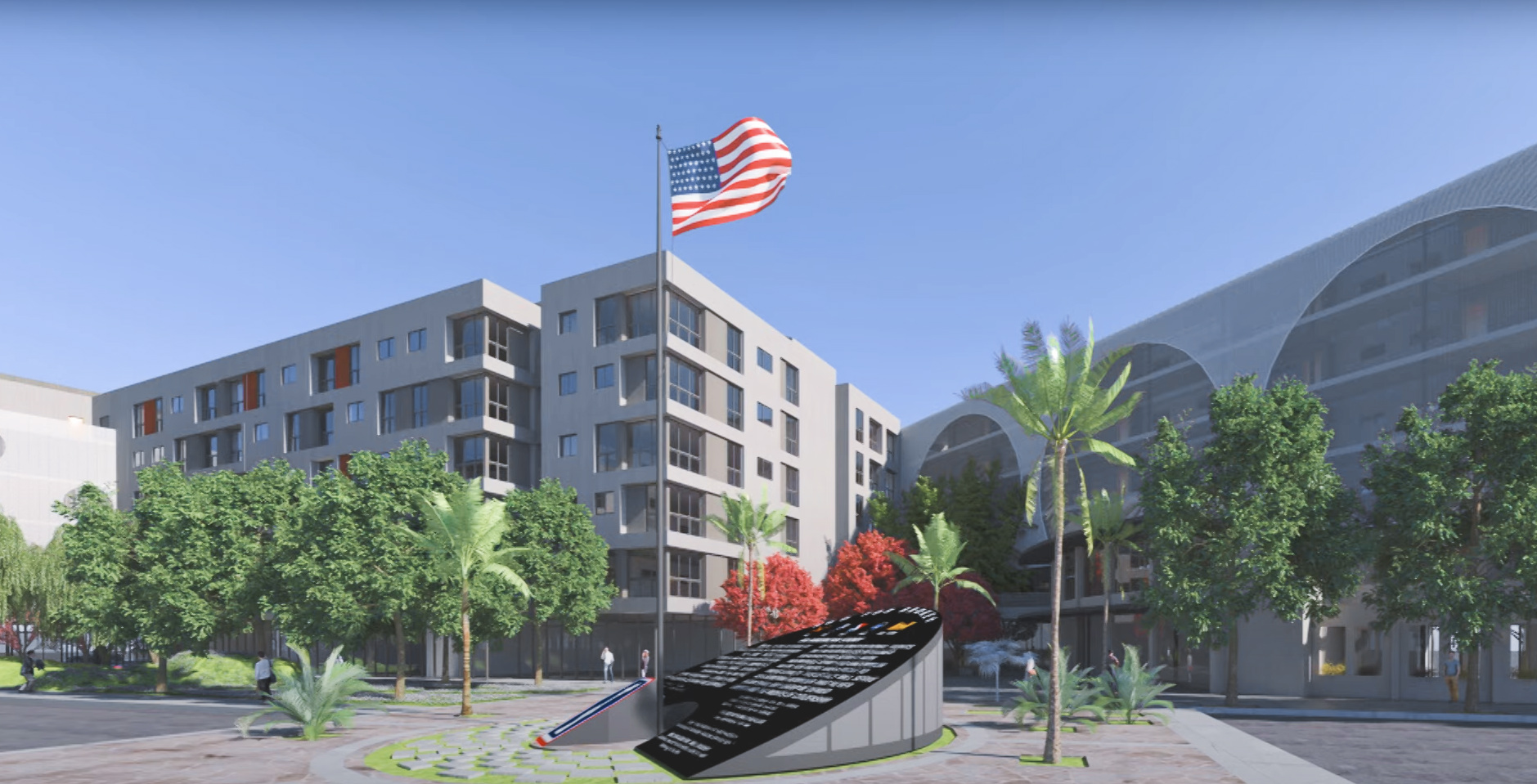
This artistic rendition shows how the area surrounding the Go for Broke monument is proposed to appear after completion of the First Street North project sometime in 2026.(Photo: Courtesy of GFBNEC)
As explained by Maloney at the Evening of Aloha, the First Street North project is a partnership among GFBNEC, the Little Tokyo Service Center and the City of Los Angeles that will transform the parking lot that surrounds the Go for Broke Monument, built in 1999, with a “new multipurpose, multistory building” that “will include 330,000 square feet of indoor space over five levels with a floor of subterranean parking.
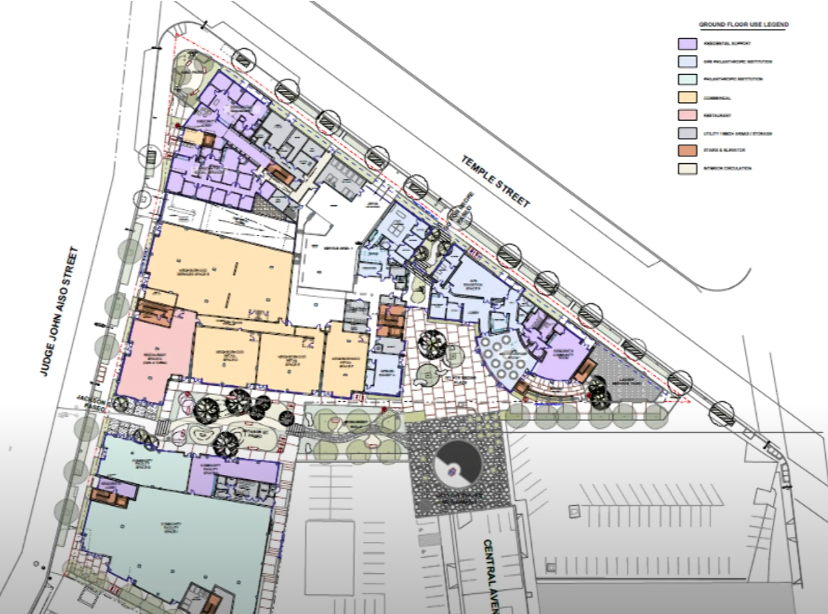
Aerial view of the First Street North project, bordered by Judge John Aiso Street (west) and Temple Street (north). The circle in the center is the Go for Broke monument. (Photo: Courtesy of GFBNEC)
It will include 248 units of badly needed affordable housing. We plan to also house several legacy J-town businesses, including Fugetsu-Do and an additional theater for East-West Players.”
Previous reporting has stated that half of the units were to be reserved for low-income families, with one-third reserved for “veterans experiencing homelessness.”
Maloney added that part of the project will also mean Go for Broke National Education Center will “take possession of a 10,000-square-foot operating space, which includes a multipurpose room for presentations and community meetings, a state-of-the-art conference room and a temporary exhibit space, and I think most exciting, an outdoor courtyard that will be designed to give the proper honor to every person whose name is inscribed on our Monument.”
According to Maki, completion of this long-discussed project will be late 2026 at the earliest, spring 2027 at the latest.
That the redevelopment will benefit the area is fitting. It was once part of historic Little Tokyo until the City of Los Angeles utilized eminent domain several decades ago to take over the land — and then used the real estate for parking.
In his remarks at Evening of Aloha, Maloney also said, “Our intent has always been to build an interpretive center next to it [the Go for Broke Monument] and to construct an additional commemorative wall that would honor the names of an additional 16,000 Japanese American Service members who served but didn’t get shipped overseas during World War II.”
Published reports have LTSC and GFBNEC paying $1 a year to rent the land. Funding will come from various sources, including government grants and funding.
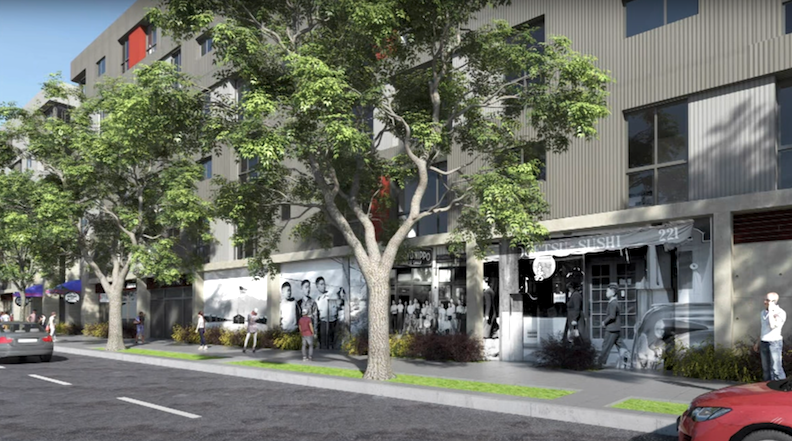
This is an artistic rendition of the First Street North project looking north along Judge John Aiso Street. (Photo: Courtesy of GFBNEC)
For Maki, who has been at the helm at GFBNEC for the past seven years, the shrinking numbers of Nisei veterans has been the impetus to take steps now to ensure a viable future for the organization.
“We’re at a point where the story is not going to live on simply because it’s a great story,” Maki said. “So, we’ve made a concerted effort to say, if we really believe that this is not just a great Japanese American story, but a great American story, then we need to really start to push this story outside of the JA community and make it relevant to members of other communities.”
Maki pointed to GFBNEC’S Torchbearer program — described on its website as a group of “engaged young adults who are locally involved and committed to the Go For Broke spirit and legacy” with local partners in other regions of the nation — and its Go for Broke Journalism Institute, which began in 2022, as avenues by which the organization’s mission can continue and expand, both within the Japanese American community and beyond it.
“We’re starting to see the fruits of that, and what’s amazing to me is when you hear young people from other communities, who may not have even heard this story before, get excited about it, and identify with it,” he said.
With the recent opening of the Terasaki Budokan, the launch of the Japanese American National Museum’s $65 million Our Promise campaign and the past summer’s opening of the Little Tokyo/Arts District Metro stop named for the late Norman Mineta, Little Tokyo is undergoing changes that should maintain and sustain the historic heart of Los Angeles’ Japanese American community.
Now, with the plans by Go for Broke National Education Center ready to begin, the stage is set for a transformative Little Tokyo renaissance.
But for Maki, it’s all about ensuring that the service and sacrifices of a previous generation are remembered by their heirs. “I think we honor their legacy by helping young people remember that the opportunities that they have today are due to the sacrifices that were made yesterday.”
(Editor’s Note: To view the video on the 22nd Evening of Aloha on YouTube, visit tinyurl.com/2s47ecar. To learn more about the Go for Broke Journalism Institute on YouTube, visit tinyurl.com/bdedfrwd.)



